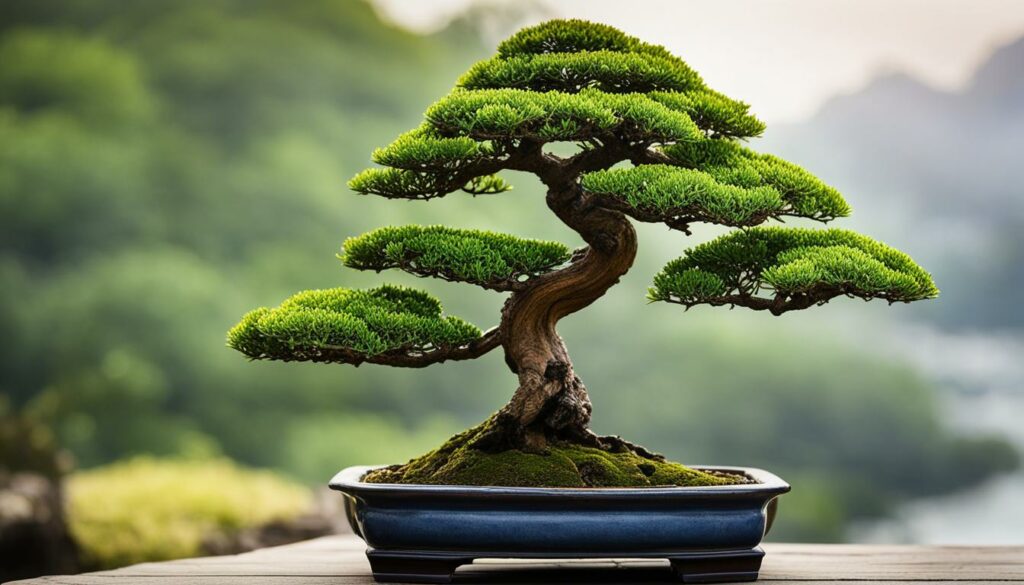Welcome to the world of beautiful and elegant Bonsai trees! In this article, we will explore Bonsai Tree Species Carmona, also known as the Fukien tea bonsai. Carmona is a popular choice among bonsai enthusiasts due to its stunning flowering display and unique features, making it a perfect addition to any indoor space.
In the following sections, we will provide you with essential Carmona care tips, discuss the ideal conditions for cultivating a tranquil indoor oasis for your Carmona bonsai, and explore different pruning and shaping techniques. We will also delve into the flowering process of Carmona bonsai and offer tips for caring for it throughout the different stages of its floral display. Finally, we will discuss common issues that may arise during Carmona care and how to identify, prevent, and treat them.
Key Takeaways:
- Carmona bonsai is also known as Fukien tea bonsai.
- Carmona is a popular choice among bonsai enthusiasts due to its stunning flowering display and unique features.
- Cultivating a tranquil indoor oasis is essential for the health and overall well-being of your Carmona bonsai.
- Pruning and shaping are crucial aspects of bonsai cultivation, allowing you to sculpt your Carmona bonsai into a work of art.
- Identifying and treating common issues, such as pest infestations, diseases, and leaf drop, is crucial for ensuring the continued health and vitality of your Carmona bonsai.
Introduction to Carmona Bonsai
Welcome to the world of Carmona bonsai! This beautiful Bonsai Tree Species Carmona is known for its elegance and is a popular choice among enthusiasts. Fukien tea bonsai, aka Carmona bonsai, is native to Southeast Asia and has its roots in China, the Philippines, and Indonesia.
The Carmona bonsai has distinct characteristics that make it an attractive choice for bonsai cultivators. Its small, shiny, green leaves are evergreen, and the tree produces tiny white flowers during spring and summer.
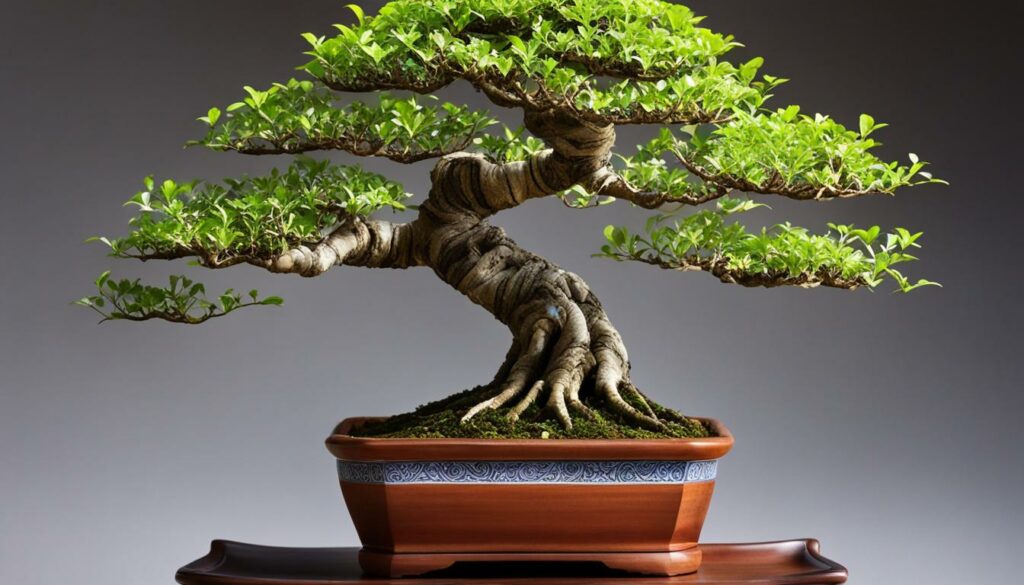
As with all bonsai, proper Carmona care is essential to maintain the tree’s health and longevity. Caring for a Carmona bonsai requires a delicate balance of light, temperature, and humidity control, as well as correct watering and pruning techniques. In the following sections, we’ll delve deeper into the essential care requirements for your Carmona bonsai and share tips on how to cultivate a tranquil indoor oasis.
Cultivating a Tranquil Indoor Oasis
Creating a serene indoor environment for your Carmona bonsai is essential for its growth and overall well-being. To provide optimal growing conditions for your bonsai tree, it is important to consider the following factors:
| Light | Temperature | Humidity | Watering |
|---|---|---|---|
| Carmona bonsai trees prefer bright, indirect light. Direct sunlight can scorch the leaves and cause damage to the tree. Consider placing your tree in a south or west-facing window with a sheer curtain to filter the light. | The ideal temperature range for Carmona bonsai trees is between 60-75°F (15-24°C). Avoid placing your tree in areas with extreme temperature fluctuations or near heating or cooling vents. | Carmona bonsai trees require higher humidity levels than the average indoor environment. Provide humidity by placing a tray filled with pebbles and water beneath the pot, misting the leaves regularly, or using a humidifier. | Water your Carmona bonsai tree when the soil feels slightly dry to the touch. Use room temperature water and ensure the excess water is drained to prevent waterlogging that can lead to root rot. |
Incorporating these tips into your Carmona care routine will help you cultivate a tranquil indoor oasis for your tree to thrive.
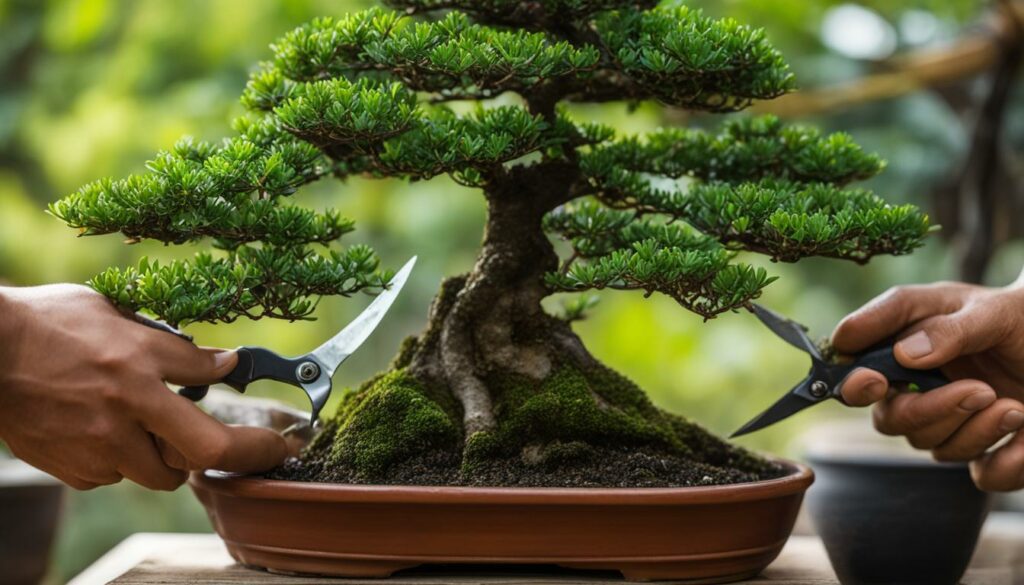
Pruning and Shaping Techniques
To create a truly beautiful Carmona bonsai, pruning and shaping are essential elements of bonsai cultivation. Carmona care requires careful attention to achieve the desired shape and structure of your bonsai. By trimming and shaping your Carmona bonsai, you can create unique artistic expressions that showcase the natural beauty of your tree.
One of the most important tools you’ll use in pruning and shaping your Carmona bonsai is the bonsai shears. These sharp, precision tools allow you to make precise cuts that won’t damage your bonsai’s delicate roots. When pruning your Carmona bonsai, it’s important to remove any dead or dying branches, as well as any branches that detract from the overall shape and structure of the tree.
When shaping your Carmona bonsai, it’s important to consider the tree’s natural growth pattern. Your goal is to highlight the unique beauty of your Carmona bonsai while maintaining a natural look that blends in with the tree’s surroundings. Common shaping techniques you can use to train your Carmona bonsai include trimming, wiring to guide branch growth, and carving to create unique shapes and features.
Trimming
Trimming is the process of removing excess branches or foliage from your Carmona bonsai. This technique is used primarily to maintain the overall health and growth of your tree. When trimming your Carmona bonsai, make sure to use sharp, clean shears to prevent damage to the tree. Trim branches that are growing too quickly, or that are obstructing the overall shape of the tree.
Wiring
Wiring is used to guide the growth and shape of your Carmona bonsai branches. This technique involves securely wrapping a thin wire around the branch and gently shaping it into the desired direction. When wiring your Carmona bonsai, be careful not to apply too much pressure or damage the branch.
Carving
Carving is a more advanced technique used to create unique shapes and features in your Carmona bonsai. This technique involves selectively removing bark and wood from the tree to create hollows, jins, and shari. When carving your Carmona bonsai, it’s important to use a sharp carving tool and work slowly and carefully.
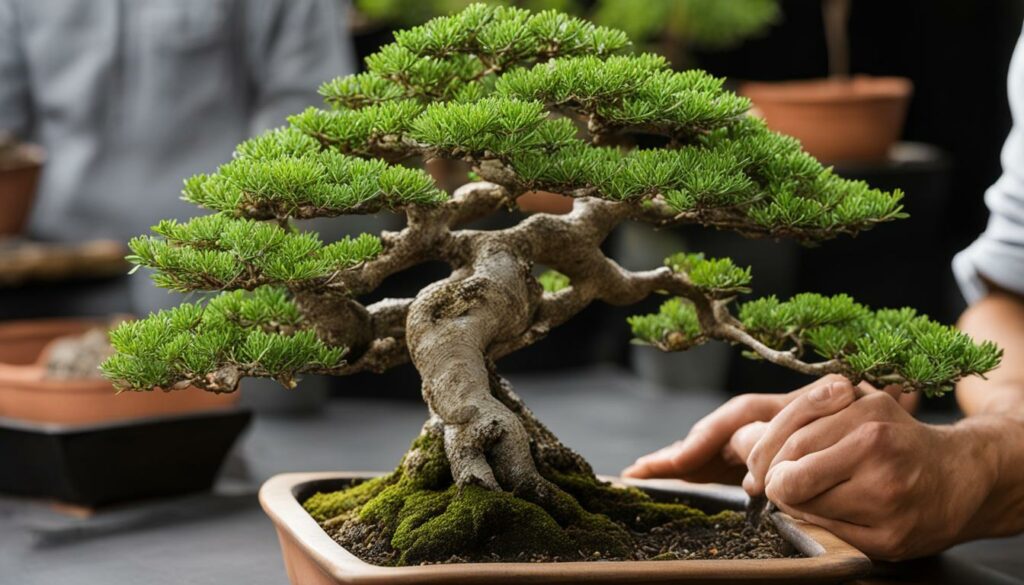
“Effective pruning and shaping techniques can transform your Carmona bonsai into a true work of art.”
By learning and applying the right pruning and shaping techniques, you can unleash the full beauty of your Carmona bonsai. These techniques, along with proper Carmona care, will help ensure the health, vitality, and longevity of your bonsai.
Flowering Beauty of Carmona Bonsai
Carmona bonsai trees are particularly renowned for the beauty of their delicate flowers. To ensure that your Carmona bonsai reaches its full potential, it’s important to understand the flowering process and how to care for it.
Before the flowering stage, it’s crucial to keep your Carmona bonsai healthy and stimulated. Make sure you maintain the ideal light, temperature, humidity, and watering requirements, which we discussed in detail in the previous section.
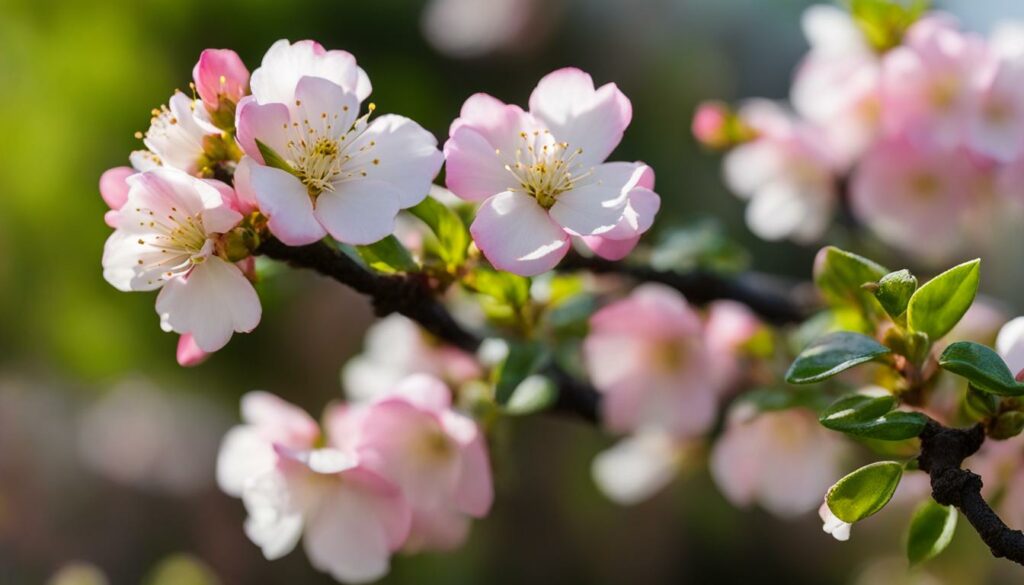
When your Carmona bonsai is ready for flowering, you’ll see buds forming at the tips of the branches. It’s essential to avoid disturbing these buds, so be careful not to over-prune your tree during this time.
To encourage abundant and vibrant blossoms, you can provide additional nutrients and fertilizers specially formulated for flowering bonsai trees. It’s also a good idea to increase the amount of light your Carmona bonsai receives, but ensure it is not direct sunlight, which can damage the fragile blossoms.
As your Carmona bonsai enters the peak of its blooming stage, make sure to protect it from pests and diseases, which can wreak havoc on the fragile flowers. If you notice any issues, refer to the troubleshooting section earlier in the article for guidance.
Troubleshooting Common Issues
Despite your best efforts in providing proper Carmona care, your bonsai tree may encounter common problems that require prompt attention to ensure its continued health and vitality. Here are some of the most frequent issues that bonsai enthusiasts encounter:
| Issue | Symptoms | Treatment |
|---|---|---|
| Pest infestations | Yellowing or spotted leaves, deformed growth, visible insects | Isolate the infected tree, spray with a suitable insecticide or treat with a homemade insecticidal soap |
| Diseases | Discoloration, fungal growth, leaf drop, stunted growth | Remove affected parts, enhance ventilation and light, treat with a fungicide or a natural remedy |
| Leaf drop | Yellowing or wilting leaves, premature leaf shedding, dry soil or overwatering | Adjust watering and fertilizing regime, check for unwanted drafts or sudden temperature changes, repot or treat for root rot if necessary |
To ensure the best possible outcomes, it is essential to identify, prevent, and treat these problems as soon as possible. It’s common for these issues to arise in bonsai cultivation, so don’t let them discourage you. With the right Carmona care and attention, you can resolve common problems and keep your bonsai tree healthy and beautiful.
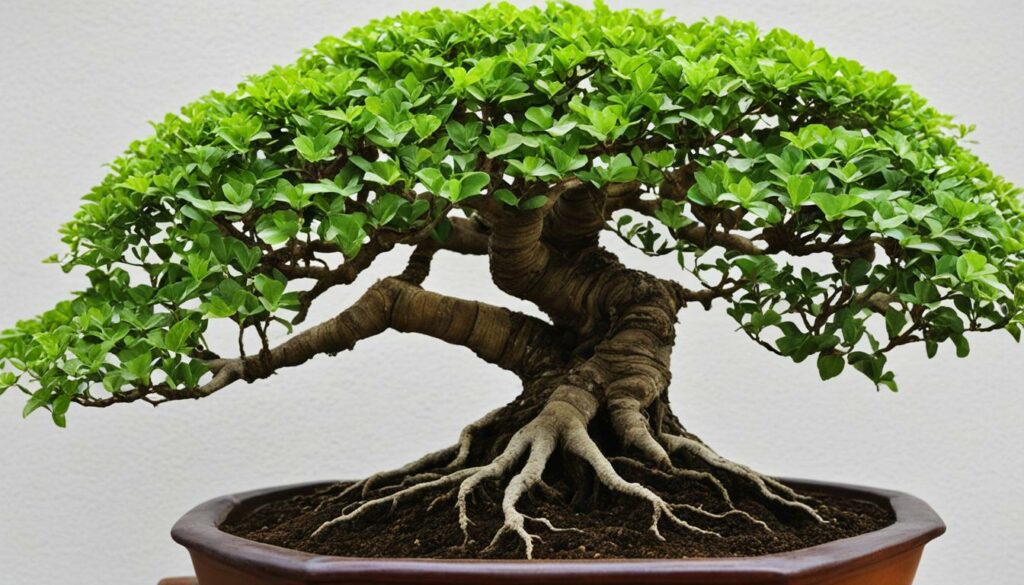
Conclusion
In conclusion, the world of bonsai cultivation offers a fascinating and rewarding journey for enthusiasts seeking to add a touch of natural elegance to their indoor spaces. The Carmona bonsai, with its unique qualities and stunning beauty, is a popular choice among bonsai enthusiasts, and for good reason. By following the guidelines provided in this article, you can embark on a fulfilling journey toward becoming a skilled bonsai cultivator and enjoy the tranquil beauty of the Bonsai Tree Species Carmona for years to come.
FAQ
What is Carmona bonsai?
Carmona bonsai refers to the practice of cultivating and shaping a Carmona tree, scientifically known as Carmona microphylla, into a miniature tree that mimics the beauty and essence of a full-sized tree. It is a popular choice among bonsai enthusiasts for its elegant appearance and stunning flowering display.
What are the care requirements for Carmona bonsai?
Carmona bonsai requires specific care to thrive. It prefers a well-lit location with indirect sunlight, temperatures between 60 to 75 degrees Fahrenheit, and high humidity levels. Watering should be done when the soil starts to dry out, keeping in mind that Carmona prefers slightly moist soil. Regular pruning and shaping are also important to maintain the desired shape and promote healthy growth.
How do I create a tranquil indoor oasis for my Carmona bonsai?
To create a serene and peaceful environment for your Carmona bonsai, place it in a well-lit area with indirect sunlight. Maintain a stable temperature between 60 to 75 degrees Fahrenheit and ensure high humidity levels by using a humidifier or placing the bonsai on a humidity tray filled with water and pebbles. Regularly misting the foliage can also help increase humidity levels. Additionally, provide proper watering and maintain a consistent pruning and shaping routine.
What pruning and shaping techniques should I use for my Carmona bonsai?
Pruning and shaping techniques for Carmona bonsai include directional pruning, thinning, and wiring. Directional pruning involves trimming branches to direct the growth of the bonsai in a specific direction. Thinning is the removal of excess branches or foliage to maintain a balanced and aesthetically pleasing shape. Wiring is the technique of using wire to gently bend and shape the branches of the bonsai. Each technique should be performed with care and precision to avoid causing harm to the tree.
How can I encourage my Carmona bonsai to flower?
To encourage flowering in your Carmona bonsai, provide it with appropriate lighting conditions, preferably bright but indirect sunlight. Maintain a consistent temperature range of 60 to 75 degrees Fahrenheit. Ensure sufficient watering, keeping the soil slightly moist. Regularly fertilize the bonsai with a balanced fertilizer during the growing season. Additionally, avoid drastic changes in environmental conditions and provide proper care to prevent stress on the tree, which can hinder flowering.
What common issues may I encounter when caring for my Carmona bonsai?
Common issues that may arise when caring for Carmona bonsai include pest infestations, such as aphids or scale insects, diseases like fungal infections or root rot, and leaf drop due to improper care or environmental stress. Regularly inspect your bonsai for signs of pests or diseases, and take proactive measures to prevent infestations or treat any issues promptly. Proper watering, lighting, and overall care can help prevent leaf drop and maintain the health of your Carmona bonsai.
